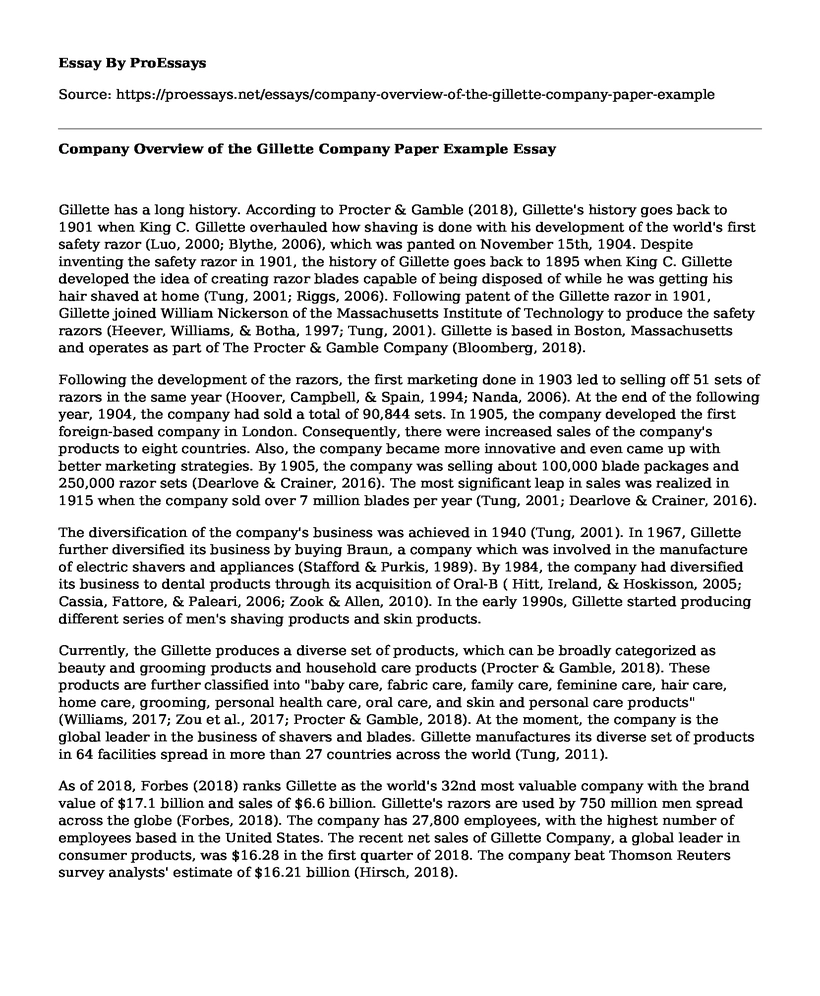Gillette has a long history. According to Procter & Gamble (2018), Gillette's history goes back to 1901 when King C. Gillette overhauled how shaving is done with his development of the world's first safety razor (Luo, 2000; Blythe, 2006), which was panted on November 15th, 1904. Despite inventing the safety razor in 1901, the history of Gillette goes back to 1895 when King C. Gillette developed the idea of creating razor blades capable of being disposed of while he was getting his hair shaved at home (Tung, 2001; Riggs, 2006). Following patent of the Gillette razor in 1901, Gillette joined William Nickerson of the Massachusetts Institute of Technology to produce the safety razors (Heever, Williams, & Botha, 1997; Tung, 2001). Gillette is based in Boston, Massachusetts and operates as part of The Procter & Gamble Company (Bloomberg, 2018).
Following the development of the razors, the first marketing done in 1903 led to selling off 51 sets of razors in the same year (Hoover, Campbell, & Spain, 1994; Nanda, 2006). At the end of the following year, 1904, the company had sold a total of 90,844 sets. In 1905, the company developed the first foreign-based company in London. Consequently, there were increased sales of the company's products to eight countries. Also, the company became more innovative and even came up with better marketing strategies. By 1905, the company was selling about 100,000 blade packages and 250,000 razor sets (Dearlove & Crainer, 2016). The most significant leap in sales was realized in 1915 when the company sold over 7 million blades per year (Tung, 2001; Dearlove & Crainer, 2016).
The diversification of the company's business was achieved in 1940 (Tung, 2001). In 1967, Gillette further diversified its business by buying Braun, a company which was involved in the manufacture of electric shavers and appliances (Stafford & Purkis, 1989). By 1984, the company had diversified its business to dental products through its acquisition of Oral-B ( Hitt, Ireland, & Hoskisson, 2005; Cassia, Fattore, & Paleari, 2006; Zook & Allen, 2010). In the early 1990s, Gillette started producing different series of men's shaving products and skin products.
Currently, the Gillette produces a diverse set of products, which can be broadly categorized as beauty and grooming products and household care products (Procter & Gamble, 2018). These products are further classified into "baby care, fabric care, family care, feminine care, hair care, home care, grooming, personal health care, oral care, and skin and personal care products" (Williams, 2017; Zou et al., 2017; Procter & Gamble, 2018). At the moment, the company is the global leader in the business of shavers and blades. Gillette manufactures its diverse set of products in 64 facilities spread in more than 27 countries across the world (Tung, 2011).
As of 2018, Forbes (2018) ranks Gillette as the world's 32nd most valuable company with the brand value of $17.1 billion and sales of $6.6 billion. Gillette's razors are used by 750 million men spread across the globe (Forbes, 2018). The company has 27,800 employees, with the highest number of employees based in the United States. The recent net sales of Gillette Company, a global leader in consumer products, was $16.28 in the first quarter of 2018. The company beat Thomson Reuters survey analysts' estimate of $16.21 billion (Hirsch, 2018).
References
Bloomberg (2018). Company overview of the Gillette Company, Inc. Retrieved from https://www.bloomberg.com/research/stocks/private/snapshot.asp?privcapId=29004
Blythe, J. (2006). Principles & practice of marketing. Cengage Learning EMEA.
Cassia, L., Fattore, M., & Paleari, S. (2006). Entrepreneurial strategy: emerging businesses in declining industries. Edward Elgar Publishing.Dearlove, D., & Crainer, S. (2016). What we mean when we talk about innovation. Infinite Ideas.
Forbes (2018). #32 Gillette. Retrieved from https://www.forbes.com/companies/gillette/#346284e510a0
Heever, J. V. den, Williams, K., & Botha, E. (1997). Brands & branding in South Africa: a time for change. Affinity Advertising and Publishing.
Hirsch, L. (2018). Procter & Gamble earnings top estimates, but market share losses send stock lower. Retrieved from https://www.cnbc.com/2018/04/19/procter-gamble-earnings-1-a-share-vs-98-cents-eps-expected.html
Hitt, M. A., Ireland, R. D., & Hoskisson, R. E. (2005). Strategic management: competitiveness and globalization cases. Thomson/South-Western.
Hoover, G., Campbell, A., & Spain, P. J. (1994). Hoover's handbook of American business. Reference Press, Inc.
Luo, Y. (2000). Multinational corporations in china: benefiting from structural transformation. Copenhagen Business School Press.
Nanda, J. K. (2006). Management thought. Sarup & Sons.Procter & Gamble (2018). History. Retrieved from https://news.gillette.com/about/history
Riggs, T. (2006). Encyclopedia of major marketing campaigns. Gale Group.
Stafford, D. C., & Purkis, R. H. A. (1989). Macmillan directory of multinationals. Macmillan.Tung, R. L. (2001). Learning from world class companies. Cengage Learning EMEA.
Williams, C. (2017). MGMT. Cengage Learning.
Zook, C., & Allen, J. (2010). Profit from the core: a return to growth in turbulent times. Harvard Business Review Press.
Cite this page
Company Overview of the Gillette Company Paper Example. (2022, Sep 07). Retrieved from https://proessays.net/essays/company-overview-of-the-gillette-company-paper-example
If you are the original author of this essay and no longer wish to have it published on the ProEssays website, please click below to request its removal:
- AutoZone Case
- How Can the Word Bank Help Solve the Issue of Literacy in Niger?
- Apple's Generic Strategy and Growth Strategies
- Vision, Values, and Mission in Leadership Essay
- Nurse Leader: Delegation and Supervising Essay Example
- Essay on Nurse With Practice/Research Doctorate: Clinical Practice + Research Leadership
- Paper Example on Reasoning & Decision-Making: Exploring Chapter 12 of Galotti (2017)







